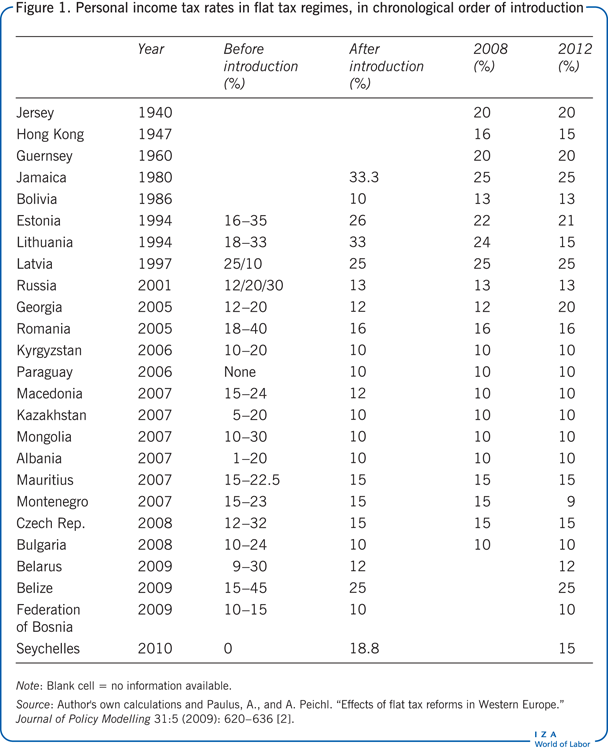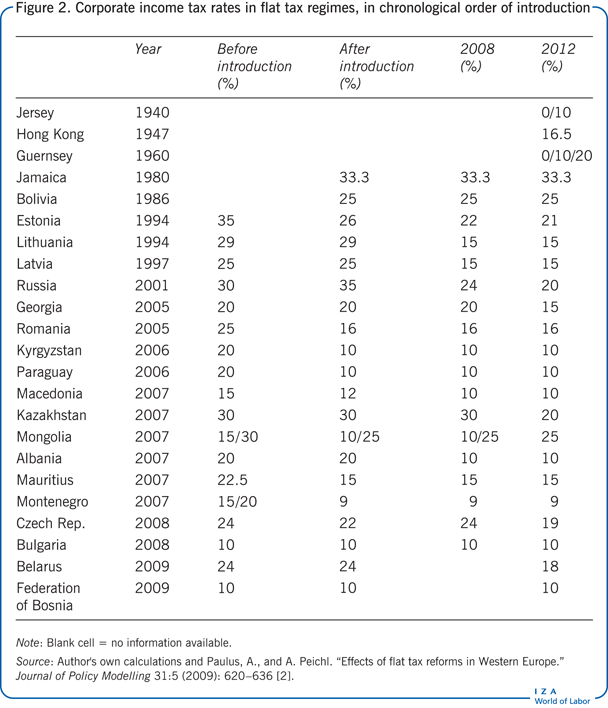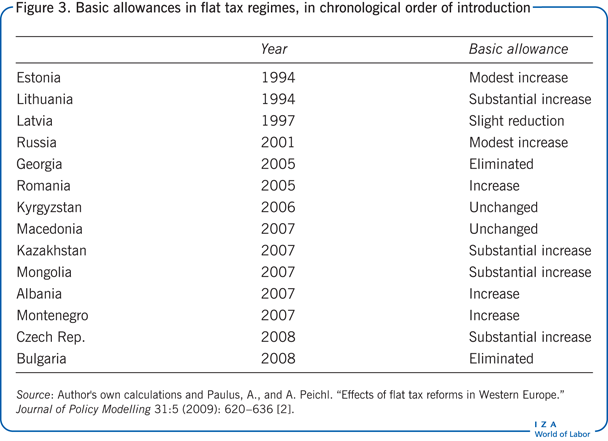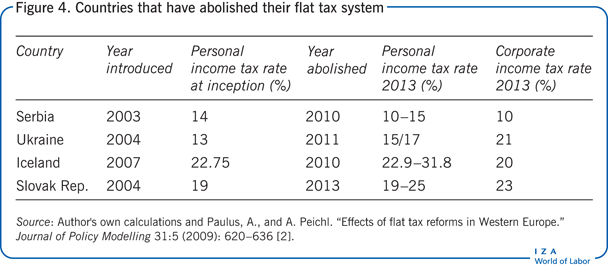Elevator pitch
The potential economic outcomes resulting from a flat rate of income tax have been the subject of an ongoing academic and political debate. Many observers have suggested that the introduction of a flat tax would be beneficial for a country’s economy, having a positive influence on the labor market and the gross domestic product by enhancing incentives to work, save, invest, and take risks. A flat tax also significantly simplifies income taxation which increases tax compliance and reduces tax planning, avoidance, and evasion. However, despite flat taxes being on the political agenda in many countries, in practice their implementation has mostly been restricted to the transition economy countries of Eastern Europe. There is no one single flat tax system in place in these countries though; one rate does not fit all.
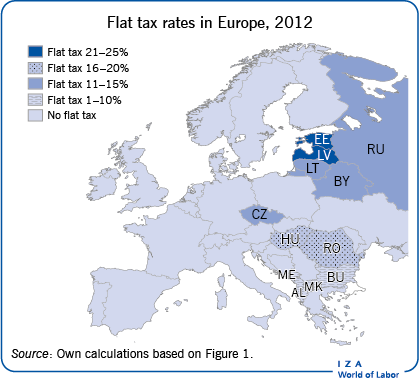
Key findings
Pros
Flat tax systems are likely to increase labor supply and employment.
Flat tax systems can lead to a simplification of the tax system.
Lower administrative and compliance costs can result from flat tax systems.
Cons
Flat tax systems are likely to lead to redistribution at the expense of the middle class.
Redistribution might cause political opposition.
Flatness of the tax schedule itself is not necessary for the positive effects of tax reform.
Author's main message
Introducing a flat-rate tax regime provides scope for improving the efficiency, equity, and simplicity of the tax system. However, most of the positive effects (higher labor supply incentives due to lower marginal rates; broadening and simplification of the tax base) can be achieved without a flat-rate schedule, while a progressive tax system can also reduce the adverse redistributive effects. Hence, introducing a flat tax is not a panacea, and the effects of such reforms depend crucially on their details and the institutional setting of the country.
Motivation
The concept of a flat income tax rate has given rise to an ongoing debate in both academia and politics. Introducing a flat income tax with a low uniform marginal tax rate and a broad tax base is supposed to bring several advantages, with positive effects on employment and gross domestic product (GDP) growth, as well as reducing tax distortions. In addition, flat tax reforms are considered to offer the promise of reduced administrative and compliance costs, as well as removing incentives for tax avoidance and evasion.
Bearing these virtues in mind, why do we see so few examples of an actual implementation of a flat tax regime? In particular, the redistributional effects appear to prevent the adoption of a flat tax rate in democracies with a well-established middle class: “[I]t is possible to have a flat tax, or to have democracy, but not both” ([1], p. 92).
This paper reviews the effects on the labor market of existing flat tax regimes and discusses the results of simulation experiments to shed light on the question of what to expect from a flat tax reform.
Discussion of pros and cons
Design of flat tax systems
Probably the most famous (academic) flat tax proposal is that associated with Robert Hall and Alvin Rabushka from 1985. They defined their “flat tax” as a comprehensive income tax with a single marginal tax rate that is also applied to business income on a cash-flow basis, while a personal allowance is available for labor income. Therefore, this flat tax is essentially a consumption tax (VAT) with a rebate for low-income households. The authors claim that their idea would be beneficial for everybody: “[T]he flat-tax plan we have developed...is, we believe, the most fair, efficient, simple, and workable plan on the table...Adopting the flat tax would improve the overall performance of the economy...Everyone’s after-tax income would rise.” Although this proposal has not been implemented in any country, it fueled the political and academic debate about flat taxes around the world, starting in the US and then continuing in Europe. The phrase “flat tax” is used more loosely within this debate, and is generally no longer associated with Hall and Rabushka.
There are many different flat tax systems. “Flatness” itself only implies that some sort of proportionality is embedded in the income tax system, i.e. income is taxed at the same (flat) rate across the whole income range. Apart from this commonality, flat tax systems differ in at least two ways: the tax schedule and the tax base.
A tax schedule may apply the same rate to all sources of income (i.e. a comprehensive tax) or different rates to different types of income (i.e. a schedular tax). Most countries with a flat tax system apply different rates to personal and corporate income, although a common rate has become more popular among the countries that have recently implemented these systems. Usually, the tax rate does not vary for different components of personal income—i.e. income from capital and from labor is taxed at the same marginal rate, independent of the level of income. There are also a number of countries that only tax capital income at a flat rate and levy a progressive rate on labor income. However, these are usually considered to be dual-income tax systems (as in the Nordic countries) rather than flat tax systems.
A “pure” flat tax implies that tax payments are proportional to income, which is only the case when there is no basic allowance or exemptions. A flat income tax as such has only been applied in Georgia and, more recently, Bulgaria. In all other cases, the tax incidence on incomes is progressive, i.e. a single marginal flat tax rate is combined with a general personal flat tax allowance. Furthermore, most countries impose further tax reliefs (on gross income) beyond the basic flat tax allowance. A further step toward overall flat tax incidence would involve integrating income tax with other taxes and benefits. An example of this is a flat tax with a refundable tax credit, effectively combining taxes and benefits due to negative income tax at low-income levels.
History of the flat tax concept
Which countries have introduced flat tax systems? The flat tax idea is nothing new. Until the first half of the 19th century, flat taxes were common throughout the world. Even in the Bible the tithe—essentially a flat tax of 10%—was paid as a tax or contribution to religious or secularized organizations (see for example Genesis 14:18–20 or Leviticus 27:30–33). Although the idea of a progressive tax found early support from the theory of justice developed by Aristotle in the Nicomachean Ethics, progressive tax schedules were first called for in modern societies by Marx and Engels in their Manifesto of the Communist Party, and they have since been adopted by most countries.
In the 20th century, flat-rate income taxes only existed in tax havens such as Hong Kong or the Channel Islands. However, the flat tax idea has been remarkably successful in the last two decades, coincidentally especially in former communist countries in Eastern Europe. In 2012, there was a total of 27 countries in the world with flat tax systems, half of them in Eastern Europe. Since its introduction in Estonia in 1994, several other countries have followed suit. Russia was the first major country to introduce a flat tax, and it also started a second flat tax wave. Figure 1 and Figure 2 show the personal and corporate income tax rates in countries with flat tax systems, in order of the year of adoption. In addition, several countries (mostly in the Middle East) have no tax on personal income, which could be considered as the flattest of all taxes, with a zero marginal rate!
There are striking differences between the tax systems that can be labeled “flat.” Most countries have introduced a flat tax rate at or close to the level of the previous lowest marginal rate, but Latvia and Lithuania have chosen to do the opposite. Some countries apply the same tax rate to personal and corporate income, as well as even to VAT (for example, the Slovak Republic). However, the pattern of setting general allowances is less clear. A fixed allowance was retained or introduced in most countries, while exceptions include Russia, with a gradual withdrawal, and Ukraine, with a sudden withdrawal above certain income levels, which makes the effective marginal tax rate high at some stages.
However, the amount of allowance varies significantly. For example, Georgia and Bulgaria have no allowance at all, whereas most countries increased allowances as part of the reforms (see Figure 3). Furthermore, the introduction of the flat tax system was accompanied in most countries by additional reforms of, for example, the tax base, social insurance contributions, benefits, indirect taxation, or tax administration. Therefore, there is no one single flat tax system in practice, but rather many different systems.
To summarize, despite many differences in their design, existing flat tax systems generally have three elements in common:
first, a single positive marginal tax rate below the previous top marginal rate;
second, a rather broad tax base in comparison with the previous system;
and third, a rather high exemption threshold.
In addition to countries that have introduced a flat tax system, four countries have abolished their flat tax (see Figure 4). In most cases, reintroducing a directly progressive income tax schedule was part of an austerity package in the aftermath of the recent economic and financial crisis. The most recent example is Slovakia, where a second rate of 25% was introduced in addition to the former flat rate of 19%. This naturally drew criticism from the opposition, which feared that the change would cause lower investment and higher unemployment. But is this true?
Expected effects of flat tax reforms
Introducing a single marginal tax rate could be justified through optimal tax theory. However, the (theoretical) optimal tax debate has not been settled, and arguments in favor [3] and against [4] the optimization of a linear tax schedule remain heavily debated. Ultimately, the results depend on the assumptions made, and particularly concern which response margins are considered in the analysis.
What can be expected from a flat tax reform? Two main benefits are usually associated with flat tax systems: increased incentives and compliance [5]:
First, flat taxes enhance incentives to work, save, invest, and take risks. This does not necessarily derive from the flatness of the tax schedule per se, but can also be attributed to other forms of reduction in (average and marginal) tax rates, especially at the top (and usually also at the bottom) of the income distribution. Despite a trend to lower marginal statutory tax rates (and reduction of the number of tax brackets), top rates can still be rather high in existing systems, for example around 40–60% in the EU-15 (European Union member countries before May 2004).
While the gains from flat and lower tax rates are explicit for the top income range, they are not so obvious for low incomes. The results depend on the chosen flat tax parameters and the underlying income distribution. If, for example, effective marginal tax rates are reduced for high-income households but raised for low- to middle-income households, the overall incentive effects will be difficult to predict and will depend on each group’s respective behavioral patterns with respect to, for example, labor supply and saving.
Second, as a flat tax is often part of a more fundamental tax reform, it can significantly simplify income taxation and therefore increase tax compliance and reduce tax planning, avoidance, and evasion. This effect is perhaps weaker in developed countries, but is often central to this kind of reform in developing and transition countries. Nevertheless, the current systems in Europe have generally evolved into quite complex entities, thus often violating the principle that taxes should be clear and simple. A simpler system is not only easier to grasp from an individual taxpayer’s perspective, but is also more transparent at the aggregated level.
Furthermore, simplification can reduce bureaucracy and therefore the costs of administration and compliance. Flatness itself only simplifies the structure of the rate schedule, which can to some extent reduce arbitrage between taxes on different sources of income. However, the primary source of complexity is, rather, the tax base itself, with its various exemptions. Other tax reforms of the type “tax rate cut cum base broadening” which simplify the tax system can also increase compliance and reduce evasion. Nevertheless, from a political economy perspective, introducing an entirely new tax system identified as “flat tax” might represent a good opportunity to fundamentally reform the existing tax system.
However, flat taxes can have a serious drawback in terms of their impact on the distribution of tax burdens [6]. Previous flat tax reforms and typical proposals for such reforms lower marginal tax rates at the high income levels but increase the tax burden for middle-income ranges (especially if they are designed to be revenue-neutral), resulting in a widening of the distribution of after-tax incomes. Therefore, the crucial question is whether a flat tax system distributes the tax burden equitably.
The answer, which is not trivial to arrive at, depends on the chosen parameter values for marginal rate and basic allowance. In terms of progressivity, a flat tax system with a basic allowance can be more or less progressive than an existing graduated rate structure, again depending on the parameter values. Moreover, the choice of these parameter values plays a key role in the expected efficiency gains in terms of incentives and compliance. A low marginal rate (and allowance) will lead to higher incentives, but also to redistribution in favor of high-income households. By contrast, a high marginal rate (and allowance) will benefit low-income households more, but will reduce incentives. In each case, middle-income households will probably lose in every (revenue-neutral) scenario. Indeed, such distributional effects could be the main limiting factor on flat tax adoption in developed countries with a well-established middle class.
To summarize, the expected effects of a flat tax are not thoroughly positive in every dimension (efficiency, equity, simplicity); nor are they unambiguous. Therefore, the next section reviews the empirical and simulation-derived evidence on flat tax reforms in the literature.
Empirical and simulation evidence on flat tax reforms
Only two actual reforms have been thoroughly analyzed: the 2001 reform in Russia and the 2004 reform in the Slovak Republic. In the Russian case, the reform was followed by significant real growth in personal income tax revenue [7]. However, there was no strong evidence that this was indeed caused by the reform itself or whether it was due to improved law enforcement; nor could any positive responses in terms of labor supply be identified. Furthermore, the situation in Russia was different from that in Western countries, insofar as the latter have a long tradition of taxation and a rather large tax administration to ensure tax compliance. Therefore, the effects of a flat tax reform on compliance are likely to be less important in developed Western countries than in the transition economies of Eastern Europe.
The Slovakian reform was expected to increase the level and efficiency of capital formation and enhance the incentives for unemployed workers to seek work. However, no evidence has been reported to date, apart from revenue-neutrality [8]. Although most real-world reforms have been very recent, research on their effects is probably limited, owing to the nature of those countries, i.e. a lack of high-quality (micro-)data for the pre-reform period. In addition, the Slovak Republic introduced its flat tax at the same time as joining the EU in 2004. Therefore, although the economy grew at rates of up to 10%, unemployment decreased from 20% to 10% and government debt fell from 50% to 21% of GDP in 2008, it is impossible to attribute these solely and causally to the flat tax reform.
In addition to the empirical evidence, there have been several simulation studies on the efficiency and equity of hypothetical flat tax reforms. One focus of these studies is the impact on employment and growth using computable general equilibrium (CGE) or macro models, usually finding positive growth and employment effects. One study used a CGE model for the Netherlands to analyze two hypothetical flat tax scenarios, finding a trade-off between equity and efficiency—i.e. an increase in either inequality or employment, or, if inequality is kept constant, reduced employment [9]. The distributional effects in favor of the top of the income distribution are confirmed in other studies, especially for the US. In addition to macrosimulation models, several microsimulation studies (for example, see [10] for Germany and the references therein for other countries) also find that the hypothetical introduction of a flat tax would redistribute in favor of high-income households and increase the labor supply (through incentives).
A cross-country study of ten EU countries has shown that the specific design, especially the flat tax rate and tax-free threshold, and the context of the reform, especially the underlying income distribution and the institutional background, play key roles in the outcome of a flat tax reform [2]. The analysis emphasizes that the flatness of the tax schedule itself is not a key feature of the economic success of a tax reform, and that other elements (simplification, increased compliance, corporate taxation) play a more important role.
Furthermore, there is not a unique flat tax effect, in that the design and the type of welfare state determine the outcome of a flat tax reform. Improved incentives and reduced inequality are jointly possible, albeit only with specific details and in specific environments. Therefore, due to its adverse short-term distributional effects, the chances of the flat tax concept invading mature democracies are rather low. However, a further movement toward lower (marginal) tax rates with broader and simpler tax bases is likely to be seen in the future. This could eventually lead to tax benefit systems moving closer to linearity, albeit without an actual flat tax schedule.
Limitations and gaps
Real empirical evidence on flat tax reforms is scarce, given that it is very challenging to convincingly identify cause and effect—to link the features of a reform to specific outcomes. To do this, more research in quasi-experimental settings is necessary. Such studies are difficult to conduct, as it is hard to find a valid control group when national taxes are changed.
The conclusions from simulation studies are also not very satisfying, ultimately suggesting that “it depends.” There are two mutually interdependent dimensions to be considered: the details of the reform; and the environment of its implementation. First, the design of a flat tax (parameters such as marginal rate and allowance, tax base simplification, and taxation of corporate cash flow) plays an important role in the results obtained. Second, the results depend crucially on the country under observation. The underlying income distribution and demographic structure, as well as the institutional background (tax benefit system, welfare state), are decisive for the outcome of such a reform.
Hence, we can at least conclude that one rate does not fit all. It follows that any country considering plans to adopt a flat-rate tax needs to conduct careful research and policy consulting that takes its specific circumstances into account.
Summary and policy advice
Introducing a flat tax provides scope for improving the efficiency, equity, and simplicity of the tax benefit system. However, these effects depend crucially on the specific details of the reform. Also, at least some of the gains could be made simply by modifying the existing progressive system.
Flattening the rate schedule can of itself reduce some distortions (for example tax arbitrage), yet is unlikely to yield significant efficiency gains. Lowering tax rates will increase the labor supply, although the size of this effect depends on the respective elasticities. The elasticity of labor supply is generally higher at the bottom of the distribution than at the top, and therefore a progressive rate schedule would be optimal.
Broadening and simplifying the tax base have positive effects, although they do not have to be combined with a flat-rate schedule. The same is true for a flat tax on corporate cash flow, which can also have positive effects.
To conclude, the evidence suggests that the world could be flat—in that the introduction of a flat tax is conceivable—but no compelling reason can be found for recommending that the world should be flat.
Acknowledgments
The author thanks two anonymous referees and the IZA World of Labor editors for many helpful suggestions on earlier drafts. The author also thanks Alari Paulus, Nico Pestel, and Sebastian Siegloch for their very helpful comments, and Marie-Luise Mann for valuable research assistance.
Competing interests
The IZA World of Labor project is committed to the IZA Guiding Principles of Research Integrity. The author declares to have observed these principles.
© Andreas Peichl
